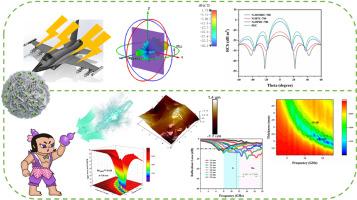Spherical porous carbon derived from Ni-DOBDC for ultra-wideband microwave absorption
IF 7.7
2区 材料科学
Q1 MATERIALS SCIENCE, COMPOSITES
引用次数: 0
Abstract
The microstructure design of new carbon nanomaterials always achieves unimaginable characteristics and performance. In this work, the influence of surface roughness (Ra) of porous carbon derived from Metal-Organic-Frameworks (MOFs) with different shapes on impedance matching and effective absorption bandwidth (EAB) has been given special attention. The rod shaped, spherical and sheet-like porous carbon materials are obtained at 700 °C from Ni-BTC, Ni-DOBDC and Ni-BPDC. The Ni-DOBDC-700 spherical porous carbon with a relatively large Ra (290 nm) exhibits excellent absorption performance. The minmium reflection loss (RLmin) is −20.8 dB at 14 GHz and the EAB can reach at 6.7 GHz (11.1–17.8 GHz) when the thickness is 2.2 mm, which covers the Ku band. The spherical porous carbon, the Ni alloys and NiO particles serves the conduction channel, the sources of magnetic loss and interface polarization, respectively. The radar cross section (RCS) value of Ni-DOBDC-700 is less than −10 dB m2 within the range of −60°–60° and the maximum scattering intensity is only −16.5 dB m2 at the thickness of 2 mm. The results provide a new design strategy for fabricating high performance Microwave Absorption Materials(MAMs) with different morophology of MOFs derived carbon materials.

Ni-DOBDC制备的球形多孔碳用于超宽带微波吸收
新型碳纳米材料的微观结构设计总是能达到难以想象的特性和性能。本文研究了不同形状金属-有机骨架(MOFs)制备的多孔碳的表面粗糙度(Ra)对阻抗匹配和有效吸收带宽(EAB)的影响。将Ni-BTC、Ni-DOBDC和Ni-BPDC在700℃下分别制备成棒状、球形和片状多孔碳材料。Ni-DOBDC-700球形多孔碳具有较大的Ra (290 nm),具有优异的吸附性能。在14 GHz时,最小反射损耗(RLmin)为−20.8 dB,当厚度为2.2 mm时,EAB达到6.7 GHz (11.1-17.8 GHz),覆盖了Ku波段。球形多孔碳、Ni合金和NiO颗粒分别作为导电通道、磁损耗源和界面极化源。Ni-DOBDC-700在−60°~ 60°范围内的雷达截面(RCS)值小于−10 dB m2,在2mm厚度处的最大散射强度仅为−16.5 dB m2。研究结果为利用不同形貌的mof衍生碳材料制备高性能微波吸收材料提供了一种新的设计策略。
本文章由计算机程序翻译,如有差异,请以英文原文为准。
求助全文
约1分钟内获得全文
求助全文
来源期刊

Composites Communications
Materials Science-Ceramics and Composites
CiteScore
12.10
自引率
10.00%
发文量
340
审稿时长
36 days
期刊介绍:
Composites Communications (Compos. Commun.) is a peer-reviewed journal publishing short communications and letters on the latest advances in composites science and technology. With a rapid review and publication process, its goal is to disseminate new knowledge promptly within the composites community. The journal welcomes manuscripts presenting creative concepts and new findings in design, state-of-the-art approaches in processing, synthesis, characterization, and mechanics modeling. In addition to traditional fiber-/particulate-reinforced engineering composites, it encourages submissions on composites with exceptional physical, mechanical, and fracture properties, as well as those with unique functions and significant application potential. This includes biomimetic and bio-inspired composites for biomedical applications, functional nano-composites for thermal management and energy applications, and composites designed for extreme service environments.
 求助内容:
求助内容: 应助结果提醒方式:
应助结果提醒方式:


